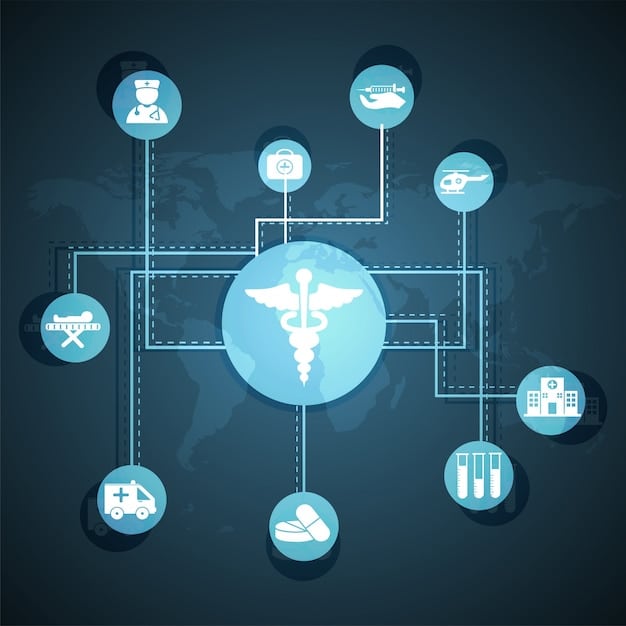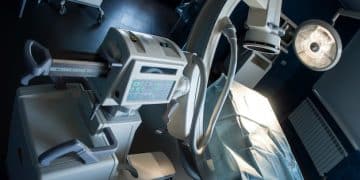Navigating the FDA: A Regulatory Guide for US MedTech Startups in 2025

US MedTech startups must navigate a complex regulatory landscape governed by the FDA; understanding this landscape is crucial for timely market entry and sustained success in 2025.
The **US MedTech Startup Regulatory Landscape: Navigating the FDA in 2025** presents a significant challenge and opportunity for innovative companies. Understanding the regulatory pathways and requirements is essential for efficient product development and successful market entry. This article provides a comprehensive guide to help MedTech startups navigate the FDA landscape effectively.
Understanding the FDA’s Role in MedTech Regulation
The Food and Drug Administration (FDA) plays a critical role in ensuring the safety and effectiveness of medical devices in the United States. For MedTech startups, understanding the FDA’s regulatory authority and processes is paramount.
Navigating this complex regulatory framework can be daunting, but it is essential for bringing life-saving and life-improving technologies to market.

FDA Regulatory Authority
The FDA’s authority over medical devices stems from the Federal Food, Drug, and Cosmetic Act. This act grants the FDA the power to regulate the development, testing, manufacturing, and distribution of medical devices.
The FDA’s oversight is categorized based on risk, with devices classified into Class I, II, or III, each requiring varying levels of regulatory scrutiny.
Device Classification: Understanding Risk Levels
Medical devices are classified into three classes based on the risk they pose to patients. Understanding these classifications is important for determining the appropriate regulatory pathway.
- Class I: Devices with low risk, such as bandages and manual stethoscopes, are subject to general controls.
- Class II: Devices with moderate risk, like powered wheelchairs and some diagnostic tests, require special controls in addition to general controls.
- Class III: High-risk devices, such as implantable defibrillators and life-sustaining devices, require premarket approval (PMA) to ensure safety and effectiveness.
The FDA’s classification system directly impacts the regulatory requirements and timelines for MedTech startups.
In conclusion, understanding the FDA’s role, its regulatory authority, and the device classification system is foundational for MedTech startups aiming to bring innovative medical devices to the US market. This knowledge enables startups to strategically plan their regulatory pathways and allocate resources effectively.
Key Regulatory Pathways for MedTech Startups
Choosing the right regulatory pathway is a critical decision for MedTech startups. The FDA offers several pathways for device approval, each with its own requirements and timelines.
Understanding these pathways and selecting the most appropriate one can significantly impact the time and cost of bringing a medical device to market.
510(k) Premarket Notification
The 510(k) pathway is the most common route for devices that are substantially equivalent to a legally marketed predicate device. This pathway requires demonstrating that the new device is as safe and effective as a device already on the market.
This pathway is often favored by startups for its relatively shorter timeline and lower cost compared to the PMA.
Premarket Approval (PMA)
The PMA pathway is required for high-risk Class III devices that are not substantially equivalent to a predicate device. This pathway requires extensive clinical data to demonstrate the safety and effectiveness of the device.

Although more rigorous and time-consuming, PMA approval offers a strong competitive advantage and market exclusivity.
De Novo Classification
The De Novo pathway is designed for novel devices that are low to moderate risk but do not have a predicate device. This pathway allows the FDA to create a new classification for the device and establish specific controls.
- Ideal for innovative technologies that do not fit existing regulatory categories.
- Requires comprehensive data to demonstrate safety and effectiveness.
- Can lead to a faster market entry compared to PMA for novel devices.
Choosing the correct regulatory pathway depends on the device’s risk class, novelty, and intended use. Startups must carefully evaluate these factors to make an informed decision.
In summary, selecting the optimal regulatory pathway is a strategic imperative for MedTech startups. By carefully considering the device’s characteristics and understanding the requirements of each pathway, startups can streamline the approval process and accelerate their time to market.
Preparing for FDA Submissions: Documentation and Testing
Preparing for FDA submissions involves meticulous documentation and rigorous testing. Comprehensive documentation ensures that all aspects of the device are thoroughly evaluated.
Meeting these requirements demonstrates the device’s safety and effectiveness, increasing the likelihood of a successful submission.
Essential Documentation Requirements
The FDA requires extensive documentation as part of the submission process. This documentation includes detailed information about the device’s design, manufacturing, and intended use.
Technical documentation, such as design specifications, risk assessments, and manufacturing process details, is crucial for demonstrating compliance with FDA regulations.
Testing and Validation Strategies
Testing and validation are essential for demonstrating the safety and effectiveness of medical devices. This includes both bench testing and clinical testing.
Bench testing validates the device’s performance under controlled conditions, while clinical testing evaluates its performance in a real-world setting.
Quality Management Systems (QMS)
Implementing a robust Quality Management System (QMS) is a critical component of FDA compliance. A QMS ensures that the device is consistently manufactured to meet quality standards.
- Adherence to QMS regulations is essential for maintaining compliance throughout the device’s lifecycle.
- A well-documented QMS facilitates efficient audits and inspections by regulatory agencies.
- Compliance with standards like ISO 13485 is often required for FDA submissions.
Effective documentation and testing are vital for navigating the FDA submission process. Startups should invest in robust systems to ensure compliance and increase their chances of success.
In conclusion, comprehensive preparation for FDA submissions, including meticulous documentation, rigorous testing, and a robust QMS, is essential for MedTech startups. These elements provide the necessary evidence to demonstrate the safety and effectiveness of their devices, paving the way for regulatory approval.
Navigating Software as a Medical Device (SaMD) Regulations
Software as a Medical Device (SaMD) is an increasingly important area of MedTech regulation. SaMD refers to software that performs a medical function without being part of a physical medical device.
Regulations for SaMD are evolving, and understanding these regulations is crucial for compliance and market access.
Defining Software as a Medical Device (SaMD)
SaMD is defined as software intended to be used for one or more medical purposes that perform these purposes without being part of a hardware medical device. This includes software that analyzes medical images, diagnoses diseases, or monitors patient health.
This definition distinguishes SaMD from software that controls a physical medical device, which is regulated differently.
Key Regulatory Considerations for SaMD
SaMD products are subject to the same regulatory requirements as traditional medical devices. This includes requirements for premarket review, quality management systems, and post-market surveillance.
However, the FDA has provided specific guidance for SaMD products, recognizing the unique challenges and opportunities associated with software-based devices.
Evolving Regulatory Guidance for SaMD
The FDA is continuously updating its regulatory guidance for SaMD products to reflect technological advancements and emerging risks. Staying informed about these changes is essential for compliance.
- FDA’s Digital Health Center of Excellence provides resources and guidance for SaMD developers.
- Participation in industry consortia and regulatory workshops can help startups stay abreast of the latest regulatory developments.
- The FDA’s pre-submission program offers an opportunity for startups to receive feedback on their SaMD products before formal submission.
Understanding and adapting to the evolving regulatory environment for SaMD is critical for startups in this space. Proactive engagement with the FDA and adherence to best practices will facilitate successful product development and market access.
In summary, navigating the regulatory landscape for Software as a Medical Device (SaMD) requires a deep understanding of evolving FDA guidance and proactive engagement with regulatory resources. By prioritizing compliance and staying informed, MedTech startups can effectively navigate the complexities of SaMD regulation and bring innovative software-based medical solutions to market.
Funding and Resources for MedTech Regulatory Compliance
Securing funding and accessing resources are critical for MedTech startups navigating the regulatory process. Regulatory compliance can be expensive, and startups need adequate financial support.
Strategic funding and access to resources can help startups navigate the regulatory landscape efficiently and effectively.
Sources of Funding for Regulatory Compliance
MedTech startups can access a variety of funding sources to support their regulatory compliance efforts. These sources includes venture capital, angel investors, government grants, and strategic partnerships.
Each funding source has its own advantages and disadvantages, and startups should carefully evaluate their options to find the best fit for their needs.
Government Grants and Programs
The US government offers several grant programs to support MedTech innovation and regulatory compliance. These programs provide financial assistance to startups engaged in medical device development.
Examples include the Small Business Innovation Research (SBIR) and Small Business Technology Transfer (STTR) programs, which provide funding for research and development activities.
Incubators and Accelerators for MedTech Startups
Incubators and accelerators play a vital role in supporting MedTech startups. These programs provide mentorship, resources, and funding to help startups navigate the regulatory process and bring their products to market.
- Incubators offer early-stage support, providing startups with office space, equipment, and access to expertise.
- Accelerators provide more intensive support, focusing on rapid growth and scaling.
- These programs often have strong connections with regulatory experts and investors, facilitating access to critical resources.
Strategic partnerships can provide access to funding, expertise, and resources that can significantly accelerate the regulatory compliance process. Startups should actively seek out these partnerships.
In conclusion, securing adequate funding and accessing relevant resources are crucial for MedTech startups aiming to navigate the regulatory landscape efficiently. By leveraging a combination of funding sources, government programs, and strategic partnerships, startups can obtain the financial and technical support needed to achieve regulatory compliance and bring their innovative medical devices to market.
Preparing for 2025: Key Trends and Predictions in MedTech Regulation
Looking ahead to 2025, several key trends and predictions are shaping the future of MedTech regulation. Understanding these trends is essential for startups to prepare for the evolving regulatory landscape.
Anticipating future regulatory changes allows startups to stay ahead of the curve and proactively address potential challenges.
Greater Emphasis on Real-World Evidence (RWE)
The FDA is increasingly incorporating Real-World Evidence (RWE) into its regulatory decision-making process. RWE is data collected from sources outside of traditional clinical trials, such as electronic health records and patient registries.
This trend reflects a growing recognition of the value of RWE in assessing the safety and effectiveness of medical devices in real-world settings.
Increased Focus on Digital Health and AI
Digital health technologies and Artificial Intelligence (AI) are transforming the MedTech industry. The FDA is actively developing regulatory frameworks to address the unique challenges posed by these technologies.
- The FDA’s Digital Health Center of Excellence is focused on promoting innovation and ensuring the safety and effectiveness of digital health products.
- Clear regulatory pathways for continuous learning AI algorithms are being developed to address concerns about bias and transparency.
- Startups developing AI-enabled medical devices should prioritize algorithm validation and data privacy to meet regulatory expectations.
Harmonization of Global Regulatory Standards
Efforts to harmonize global regulatory standards are ongoing to facilitate international market access for medical devices. This includes collaboration between regulatory agencies to align requirements and streamline approval processes.
Startups should consider global regulatory requirements early in the product development process to facilitate market access in multiple regions.
Staying informed about emerging trends and predictions in MedTech regulation is essential for startups to navigate the evolving landscape successfully. Proactive preparation will position startups for success in the future.
In summary, preparing for 2025 and beyond requires MedTech startups to anticipate and adapt to emerging trends in regulatory science. By embracing the use of Real-World Evidence, focusing on digital health and AI, and understanding the harmonization of global regulatory standards, startups can proactively position themselves for success in the evolving regulatory environment.
| Key Aspect | Brief Description |
|---|---|
| 💡 FDA’s Role | Ensuring device safety and effectiveness through regulation. |
| ✅ Regulatory Pathways | Choosing the correct pathway (510(k), PMA, De Novo) is crucial for market entry. |
| 💰 Funding and Resources | Strategic funding is critical for regulatory compliance. |
| 🔮 Future Trends | Emphasis on RWE, AI, and global harmonization. |
FAQ
▼
The FDA is responsible for ensuring the safety and effectiveness of medical devices sold in the US by regulating their development, testing, manufacturing, and distribution.
▼
The main pathways include 510(k) for devices substantially equivalent to existing ones, PMA for high-risk devices, and De Novo for novel devices without a predicate on the market.
▼
Essential documents include detailed design specifications, risk assessments, manufacturing process details, and data from bench and clinical testing that validates the device’s safety and effectiveness.
▼
SaMD products are regulated like traditional medical devices, requiring premarket review, adherence to quality management systems, and post-market surveillance, subject to the FDA’s specific guidance.
▼
Startups should prepare for increased emphasis on Real-World Evidence, focus on digital health and AI innovations, and the ongoing harmonization of global regulatory standards.
Conclusion
Navigating the **US MedTech Startup Regulatory Landscape: Navigating the FDA in 2025** requires a comprehensive understanding of FDA regulations, strategic planning, and proactive preparation. By focusing on compliance, leveraging resources, and staying informed about emerging trends, MedTech startups can successfully bring their innovative medical devices to market and improve patient outcomes.





